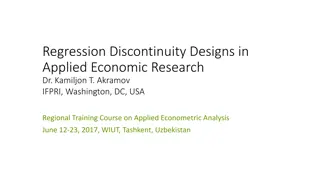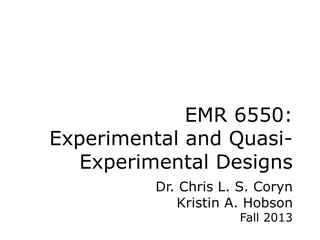Understanding Quasi-Experiments in Research
Quasi-experiments are research studies that resemble experiments but do not involve random assignment of participants to treatment groups. This approach is taken when random assignment is challenging or when ethical considerations come into play. Unlike true experiments, quasi-experiments can provide valuable insights into causal relationships among variables in existing groups. Explore the differences between true experiments and quasi-experiments to better comprehend their applications in research.
Download Presentation

Please find below an Image/Link to download the presentation.
The content on the website is provided AS IS for your information and personal use only. It may not be sold, licensed, or shared on other websites without obtaining consent from the author. Download presentation by click this link. If you encounter any issues during the download, it is possible that the publisher has removed the file from their server.
E N D
Presentation Transcript
Research Objective Study relationships among variables for existing groups Show direct cause & effect Explain outcomes after the fact
Type of Design Cross-Sectional Longitudinal True Experiment Quasi-Experiment Explanatory Case Study Exploratory Case Study
What Are Quasi-Experiments? Quasi-experiments are just like experiments except for one thing. They violate the condition of random assignment of test subjects to treatment and control groups.
Why Do This? There are two main reasons why researchers fail to achieve the random assignment assumption: It is difficult or impossible to achieve random assignment because the participants are embedded in groups Example: students in classes There are ethical reasons for assigning some participants to the treatment group Example: potentially life-saving new drug
The Classic Experiment Select representative sample Randomly assign to control and treatment groups Measure the outcome (dependent) variable for both groups Do something to the treatment group Measure the outcome variable again for both groups
True Experiment Did you select a representative sample of test cases from a single homogenous population? Yes Not a True Experiment No Did you assign test subjects or cases randomly to treatment and control groups? Yes No Not a True Experiment Did you then do something to treatment groupsthat you did not do to the control group and then mea- the responses of both treatment & control groups? Not a True Experiment Yes No True Experiment
Quasi-Experiment Did you select a representative sample of test cases from a single homogeneous population? YES No Not a quasi-experiment Did you ASSIGN test subjects to treatment & control groups NON-randomly? No Not a quasi-experiment YES Did you then do something to treatment groups that you did not do to the control group? No Not a quasi-experiment YES Quasi-Experiment
Non-Equivalent Group Designs One of the most common reasons for going to a quasi-experiment is that your potential test subjects are naturally embedded in some larger groups. Students in classes Hospital patients in wards Participants in an intervention program Monkeys in troops
Subjects Embedded in Groups There is a new set of experiential learning materials about environmental education for high school students. You believe that this way of learning about the environment is more apt to produce change in behavior than traditional methods. Things like recycling, turning off the lights, not letting the water run while you brush your teeth.
Your Subjects You get three of seven science teachers in a school district to agree to try the new approach. The other 4 will use the old approach. Your test subjects are students in their classes. You will measure behavior (how often they recycle, etc.) before and after the education, new or traditional.
The Problem This looks just like a true pre-post measurement experiment. Tr M1 S Co M1 M2 M2 The problem is that your test subjects, the students, come in groups. You did not assign Student A to control and Student B to treatment.
The Threat The big problem with this design is that you cannot be really sure that the control and treatment groups are equivalent. For example, what if the 3 teachers who agree to try the new approach are just better teachers and their students are therefore more motivated?
Key Concepts What s the same and what s different between a true and a quasi-experiment.
The DIFFERENCE Quasi-experiments differ from true experiments in only one way: there is no random assignment of individual participants to treatment and control groups. This makes it much harder to control non- treatment variance. It greatly increases threats to internal validity. It can also increase threats to external validity. It reduces explanatory power.























